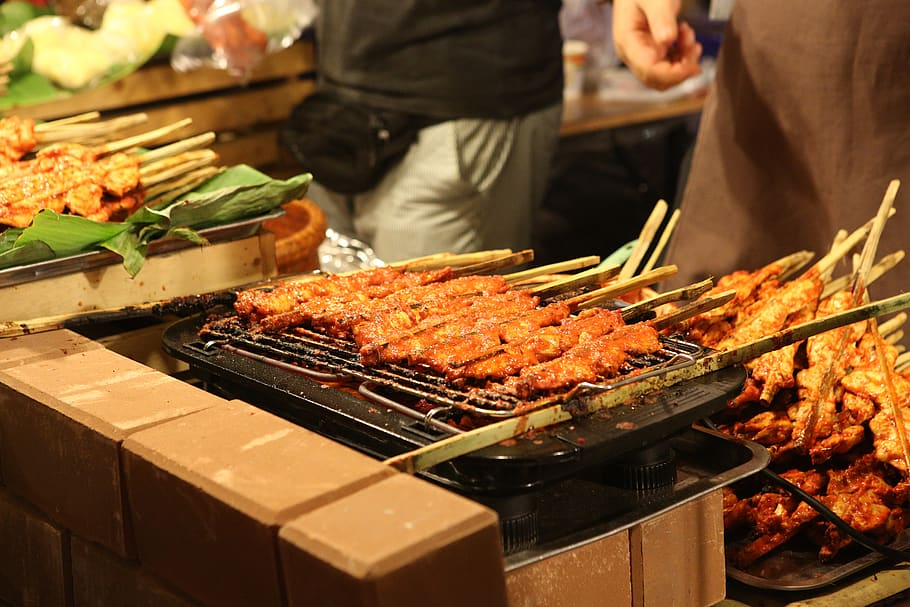
Bangkok’s street food scene is a legendary spectacle, an exhilarating symphony of sights, sounds, and, most importantly, flavors. From bustling night markets to humble roadside stalls, the city offers an unparalleled culinary adventure that caters to every palate and budget. Eating street food in Bangkok isn’t just about sustenance; it’s an immersion into the local culture, a vibrant testament to the city’s dynamic energy and gastronomic prowess.
Navigating the endless array of options can be daunting for first-timers. Here are some essential dishes you absolutely must try:
No exploration of Thai street food is complete without tasting Pad Thai. This iconic stir-fried noodle dish features thin rice noodles, eggs, tofu, shrimp or chicken, bean sprouts, and chives, all tossed in a sweet-savory-tangy tamarind-based sauce. It’s often garnished with crushed peanuts, lime wedges, and fresh banana blossoms, allowing diners to customize their flavor profile.
Guay Teow encompasses a vast category of noodle soups, each offering a unique experience. You’ll find variations like:
A refreshing and fiery staple from Isaan (northeastern Thailand), Som Tum is a vibrant salad made by pounding shredded green papaya, tomatoes, long beans, peanuts, dried shrimp, and chilies in a mortar and pestle. The dressing is a potent mix of fish sauce, lime juice, and palm sugar, delivering a perfect balance of spicy, sour, salty, and sweet.
Pad Kra Pao is a quick, easy, and incredibly popular stir-fry. It typically features minced pork, chicken, or beef stir-fried with holy basil (kra pao), garlic, and chilies, all seasoned with fish sauce and oyster sauce. It’s almost always served over steamed rice with a fried egg (kai dao) on top.
Hoy Tod is a crispy oyster or mussel omelette. The seafood is cooked with a starchy batter until it’s wonderfully crisp on the outside and gooey on the inside, often with bean sprouts and a tangy chili sauce. It’s a textural delight that’s both savory and satisfying.
For those with a sweet tooth, Kanom Krok are delightful grilled coconut pancakes. Made from a batter of coconut milk, rice flour, and sugar, they are cooked in a special dimpled pan until golden brown and slightly crispy on the edges, with a creamy, custardy center. They are often served plain or with toppings like corn or spring onions.
A quintessential Thai dessert, Khao Niao Mamuang is a seasonal favorite, particularly during mango season (typically March to May). It consists of sweet glutinous rice cooked with coconut milk, served alongside fresh, ripe mango slices and drizzled with more sweetened coconut cream, often with a sprinkle of crispy mung beans.
Bangkok is replete with street food stalls in almost every neighborhood, but some areas are particularly renowned for their concentration and variety:
At night, Yaowarat transforms into a vibrant culinary hub. This area is famous for its diverse Chinese-Thai cuisine, ranging from delicious seafood and dim sum to incredible noodle dishes, roasted duck, and unique desserts. Don’t miss the oyster omelettes (Hoy Tod) and various noodle soups here.
Located across the Chao Phraya River from Wat Arun, Wang Lang Market is a bustling local market that offers an authentic street food experience away from the main tourist crowds. You’ll find a vast array of Thai dishes, fresh seafood, and tempting desserts at very reasonable prices.
Often cited as one of the best fresh markets in the world, Or Tor Kor offers a cleaner, more organized, and slightly pricier street food experience. Here, you can sample high-quality prepared dishes, fresh fruits, and gourmet Thai ingredients. It’s an excellent place to try regional specialties from across Thailand.
One of Bangkok’s oldest roads, Charoenkrung is a treasure trove of street food stalls and traditional shophouse eateries. This area offers a blend of old-school Thai dishes, Chinese influences, and even some Indian and Muslim Thai food. Explore its alleys for hidden gems.
Don’t limit yourself to the famous hotspots. Many of the best street food experiences can be found by simply walking through local neighborhoods and looking for stalls with long queues or those that seem busy with locals. Areas around BTS or MRT stations often have fantastic street food options during lunch and dinner hours.
To make the most of your culinary adventure, keep these tips in mind:
Look for stalls that are busy with locals – a good sign of fresh ingredients and quick turnover. Observe the cleanliness of the stall, the cooking surfaces, and how ingredients are handled. Most reputable vendors maintain high hygiene standards.
Thai food can be very spicy. If you’re sensitive to heat, you can often say “mai phet” (not spicy) or “phet noi” (a little spicy). However, some dishes are meant to be fiery, so be prepared!
Most street food vendors operate on a cash-only basis, and it’s best to have small denominations (20, 50, 100 baht notes) to make transactions easier.
Don’t be afraid to try what the locals are eating. Pointing to dishes or other diners’ plates can be a helpful way to order if there’s a language barrier.
Part of the charm of Bangkok’s street food is the unpredictable nature of discovery. Be open to trying new things, even if you don’t know exactly what they are. You might just stumble upon your new favorite dish.